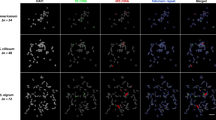Abstract
The most widely cultivated species of cotton,Gossypium hirsutum, is a disomic tetraploid (2n=4x=52). It has been proposed previously that extant A- and D-genome species are most closely related to the diploid progenitors of the tetraploid. We used fluorescent in situ hybridization (FISH) to determine the distribution of 5S and 18S-28S rDNA loci in the A-genome speciesG. herbaceum andG. arboreum, the D-genome speciesG. raimondii andG. thurberi, and the AD tetraploidG. hirsutum. High signal-to-noise, single-label FISH was used to enumerate rDNA loci, and simultaneous, dual-label FISH was used to determine the syntenic relationships of 5S rDNA loci relative to 18S–28S rDNA loci. These techniques provided greater sensitivity than our previous methods and permitted detection of six newG. hirsutum 18S–28S rDNA loci, bringing the total number of observed loci to 11. Differences in the intensity of the hybrizization signal at these loci allowed us to designate them as major, intermediate, or minor 18–28S loci. Using genomic painting with labeled A-genome DNA, five 18S–28S loci were localized to theG. hirsutum A-subgenome and six to the D-subgenome. Four of the 11 18S–28S rDNA loci inG. hirsutum could not be accounted for in its presumed diploid progenitors, as both A-genome species has three loci and both D-genome species had four.G. hirsutum has two 5S rDNA loci, both of which are syntenic to major 18S–28S rDNA loci. All four of the diploid genomes wer examined contained a single 5S locus. InG. herbaceum (A1) andG. thurberi (D1), the 5S locus is syntenic to a major 18S–28S locus, but inG. arboreum (A2) andG. raimondii (D5), the proposed D-genome progenitor ofG. hirsutum, the 5S loci are syntenic tominor and intermediate 18S–28S loci, respecitively. The multiplicity, variation in size and site number, and lack of additivity between the tetraploid species and its putative diploid ancestors indicate that the behavior of rDNA loci in cotton is nondogmatic, and considerably more complex and dynamic than previously envisioned. The relative variability of 18S–28S rDNA loci versus 5S rDNA loci suggests that the behavior of tandem repearts can differ widely.
Similar content being viewed by others
References
Anderson P, Roth R (1981) Spontaneous tandem genetic duplications inSalmonella typhimurium arise by unequal recombination between rRNA cistrons. Proc Natl Acad Sci USA 78: 3113–3117
Arnheim N, Krystal M, Schmickel R, Wilson G, Ryder O, Zimmer E (1980) Molecular evidence for genetic exchanges among ribosomal genes on nonhomologous chromosomes in man and ape. Proc Natl Acad Sci USA 77:7323–7327
Beasley JO (1940) The origin of American tetraploidGossypium species. Am Nat 74:285–286
Beasley JO (1942) Meiotic chromosome behavior in species, species hybrids, haploids and induced polyploids ofGossypium. Genetics 27:25–54
Bennett MD (1982) Nucleotypic basis of the spatial ordering of chromosomes in eukaryotes and the implications of the order for genome evolution and phenotypic variation. In: Dover GA, Flavell RB (eds) Genome evolution. Academic Press, London, pp 239–262
Crane CF, Price HJ, Stelly DM, Czeschin DG, McKnight TD (1993) Identification of a homeologous chromosome pair bysitu hybridization to ribosomal RNA loci in meiotic chromosomes of cotton (Gossypium hirsutum L.). Genome 36: 1015–1022
Edwards GA, Mirza MA (1979) The designation of a new G genome forGossypium bickii Can J Genet Cytol 21: 367–372
Endrizzi JE, Turcotte EL, Kohel RJ (1985) Genetics, cytology, and evolution ofGossypium, Adv Genet 23:271–375
Fryxell PA (1992) A revised taxanomic intepretation ofGossypium L. Rheedea 2:108–165
Hanson RE, Zwick MS, Choi SD, Islam Faridi MN, McKnight TD, Wing RA, Price HJ, Stelly DM (1995) Fluorescent in situ hybridization of a bacterial artificial chromosome. Genome 38:646–651
Islam-Faridi MN, Mujeeb-Kazi A (1995)Secale cereale DNA in wheat germplasm; visualization by fluorescent in situ hybridization and breeding application. Theor Appl Genet 90: 595–600
Jewell DC, Islam-Faridi MN (1994) Details of a technique for somatic chromosome preparation and C-banding of maize. In: Freeling M, Walbot V (eds) The maize handbook. Springer, Berlin Heidelberg New York, pp 484–493
Menzel MY (1954) A cytological method for genome analysis inGossypium. Gennetics 40:214–223
Paterson AH, Brubaker KL, Wendel JF (1993) A rapid method for extraction of cotton (Gossypium spp.) genomic DNA suitable for RFLP or PCR analysis. Plant Mol Biol Rep 11:122–127
Price HJ, Stelly DM, McKnight TD, Scheuring CF, Raska D, Michaelson MJ, Bergey D (1990) Molecular cytogenetic mapping of a nucleolar organizer region in cotton. J Hered 81: 365–370
Reinisch AJ, Dong J, Brubaker CL, Stelly DM, Wendel JF, Paterson AH (1994) A detailed RFLP map of cotton,Gossypium hirsutum×Gossyptium barbadense: chromosome organization and evloution in a disomic polyphoid genome. Genetics 138: 829–847
Seperack P, Slatkin M, Arnheim N (1988) Linkage disequilibrium in human ribosomal genes: implications for multigene family evolution. Genetics 119:943–949
Silhavy TJ, Berman ML, Enquist LW (1984) Experiments with gene fusion. Cold Spring Harbor Laboratory Press, Cold Springer Harbor, New York, pp 144–146
Skovsted A (1934) Cytological studies in cotton. II. two interspecific hybrids between Asiatic and New World cottons. J Genet 28:407–424
Wendel JF (1989) New World tetraploid cottons contain Old World cytoplasm. Proc Natl Acad Sci USA 86:4132–4136
Wendel JF, Albert VA (1992) Phylogenetics of the cotton genus (Gossypium L.): character-state weighted parsimony analysis of chloroplast DNA restriction site data and its systematic and biogeographic implications. Syst Bot 17: 115–143
Wendel JF, Schnabel A, Seelanan T (1995) Bidirectional interlocus concerted evolution following allopolyploid speciation in cotton (Gossypium) Proc Natl Acad Sci USA 92:280–284
Author information
Authors and Affiliations
Corresponding author
Additional information
Edited by: R. Appels
Rights and permissions
About this article
Cite this article
Hanson, R.E., Nurul Islam-Faridi, M., Percival, E.A. et al. Distribution of 5S and 18S–28S rDNA loci in a tetraploid cotton (Gossypium hirsutum L.) and its putative diploid ancestors. Chromosoma 105, 55–61 (1996). https://doi.org/10.1007/BF02510039
Received:
Revised:
Accepted:
Issue Date:
DOI: https://doi.org/10.1007/BF02510039




